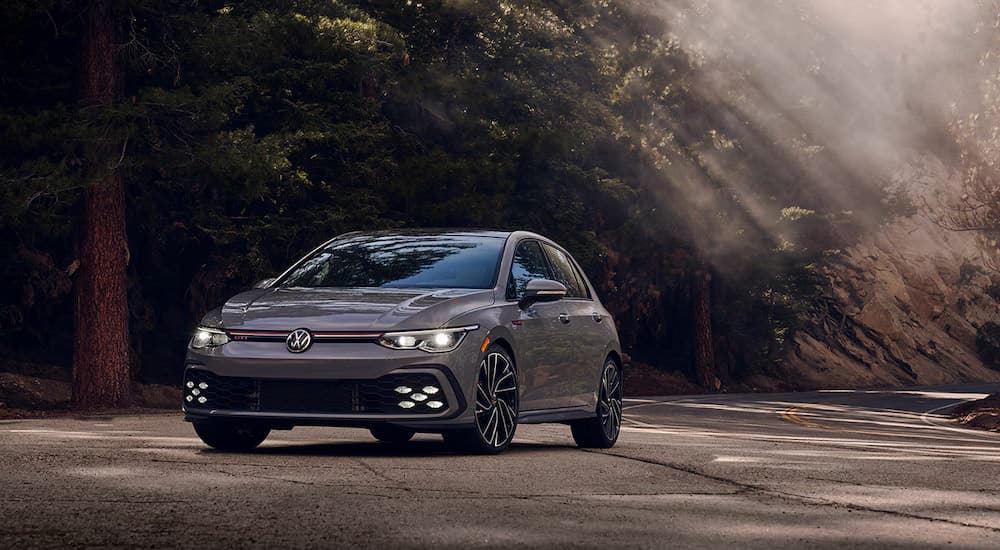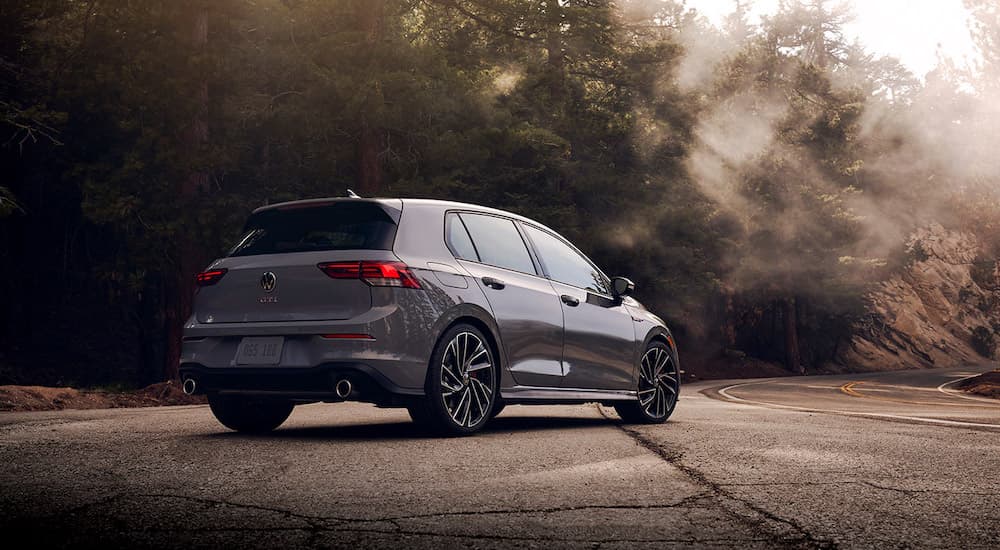In the world of performance-oriented hatchbacks, the Volkswagen Golf GTI is a legitimate trailblazer. VW might not have invented the “hot hatch” concept––that honor would go to the short-lived Italian brand Autobianchi––but it did bring the idea to the masses, catering to a new generation of young, thrill-seeking drivers with a sport-tuned version of its popular Golf compact.
While VW once offered a full lineup of Golf models, those on the hunt for a Volkswagen Golf for sale will have noticed there are now just two models on offer: the Golf GTI and Golf R. VW decided to discontinue the base Golf in 2022, leaving these two performance-oriented models to choose from. What are the differences between the Golf GTI and Golf R, and which is the sportiest version of the popular Golf compact? Read on as we compare the GTI and R, look at each version’s history, and see how one stubborn marketing executive stumbled upon an idea that would stand the test of time.
Besting the Bug
Before we dive too deep into the Golf GTI and Golf R, a word on hot hatches. While there’s no strict classification, most drivers would agree that the concept refers to any compact hatchback that’s been redesigned with a more powerful engine, improved handling, and a sportier appearance. Upgraded suspension, brakes, and tires are par for the course when it comes to hot hatches, making them the perfect choice for a few asphalt antics (just don’t tell the German Parliament, but more on that later).
Hot hatches offer a number of advantages over pure sports cars, largely in terms of practicality. While it’s fun to take a few laps behind the wheel of a high-performance coupe, they don’t tend to be the most comfortable, roomy, or convenient options on the market. Hot hatches manage to hit the sweet spot between performance and practicality, giving drivers a flexible vehicle that’s just as home on the track as it is running errands around town.
There’s no denying the cultural impact of the Volkswagen Beetle. With more than 21 million units produced over the car’s 65-year production run, the quirky compact left an indelible mark on both automotive history and popular culture. Eager to capitalize on the success of that 1960s icon, Volkswagen began working on the Beetle’s follow-up in the early 1970s. The German brand had three goals for its new mass-market model: it had to be able to fit the whole family, excel as a long-range commuter, and, most importantly, remain affordable to the average driver.
The result was the Volkswagen Golf, an alluring new compact that replaced the familiar rear-engine/rear-wheel drive formula of the Beetle with a new front-engine/front-wheel drive design more suited to modern automotive sensibilities. The car was an instant success, posting strong sales and proving that Volkswagen wasn’t some one-hit wonder. While the Golf might have never become the cultural touchstone that the Beetle was, it actually bested the bug in sales, with more than 35 million units sold since 1974. Those are strong enough numbers to not only make the Golf Volkswagen’s best-selling model but one of the top three best-selling vehicles of all time.
Enter the GTI
The first-generation Golf––which was actually known as the Volkswagen Rabbit in the United States until 1984––was an unbridled success, and the Volkswagen establishment would have likely been content to quit while they were ahead if not for the dogged insistence of VW marketing executive Anton Konrad. While Konrad wasn’t an engineer, he was plugged into the German automotive scene and saw some potential in developing a more powerful, performance-oriented version of the fledgling Golf. “I thought that it is possible to attract young drivers, get them closer to VW,” said Konrad in 2016. “My idea was to come up with a car with more power…give the car all the genes that are necessary in motorsports. But the car had to be used in the city, on the autobahn, and for leisure. It was also about private people using their own money to tune their car to their liking.”
Without knowing it, Konrad had single-handedly invented the hot hatch, pushing in a new automotive concept that would become an undeniable force in the world of motorsports and tuning. While rolling out a more powerful, racing-focused version of a popular model might be par for the course in today’s Germany, the project actually faced significant resistance in the early days. VW had found itself in some hot water in 1973 when it introduced a sportier version of the Beetle dubbed the Beetle GSR (Gelb Schwarzer Renner or “Yellow and Black Racer”). While relatively tame by today’s standards at just 50 hp, the Beetle GSR’s power and splashy paint job caused such a stir that the compact was even denounced in the German Parliament. Stodgy politicians worried that the racy Beetle was an invitation to vehicular tomfoolery––“hooning,” in modern parlance––so VW was reluctant to roll out a similarly souped-up version of the new Golf.
Still, Konrad wasn’t to be deterred and gathered a skunkworks team of engineers to work on the project in secret. The result was the GTI, which injected some excitement into the Golf with a 1.6-liter engine sporting a revised compression ratio and 108 hp, lower ride height, ventilated disc brakes, anti-roll bars, a larger front spoiler, black-plastic wheel arch extensions, and a number of other small changes. With a top speed of 113 mph and a zero to 60 mph time of 9.2 seconds, the GTI was a revelation in its day, proving just how thrilling a compact like the Golf could be with just a few tweaks.
Konrad got his “told you so” moment in short order, with the Golf GTI moving 30,000 units in 1976 and more than 420,000 by the end of the compact’s first generation. The Rabbit GTI arrived on American shores in 1983 but would see its name changed to the Golf GTI by 1985. The GTI won plenty of praise in its early days, with Sports Car International naming the first-generation version the third-best car of the 1980s and the second-generation model landing Motor Trend’s coveted Car of the Year award in 1985.
The Next Level of Performance
The Golf R32 Mk 4––the predecessor to today’s Golf R––was introduced in 2002, becoming the first version of the compact to bear the Volkswagen R badge. Powered by a 3.2-liter VR6 engine with 240 hp and coming standard with VW’s 4Motion all-wheel drive, the Golf R was also the first European production vehicle to feature a DSG dual-clutch transmission. The inclusion of the dual-clutch gearbox is all the more crazy when you consider the fact that even established sports car brands like Ferrari hadn’t yet fielded the technology.
VW would follow the fourth-generation R32 up with the R32 Mk 5 in 2005, which boasted Recaro wingback seats and a zero to 60 mph time of 6.2 seconds, but it wasn’t done perfecting the model quite yet. The hot hatch would lose its numerical suffix––and limited edition designation––in 2009 when VW rolled out the Golf R. Gone was the 3.2-liter VR6, replaced by a 2.0-liter turbocharged engine that put out an impressive 256 hp.
The Golf R is to the Golf GTI what the Golf GTI is to the base Golf, supplementing the compact’s impressive performance with a host of high-performance upgrades that make the R the most exciting Golf on offer. The R features improved cylinder heads, valves, and pistons, a larger intercooler than the GTI, and an upgraded turbocharger. In 2013, the Golf R Mk 7 would add quad-exit exhaust, DCC adaptive damping, and launch control that rocketed the R from zero to 60 mph in less than five seconds.
Modern Marvels
Where does the Golf GTI vs Golf R rivalry stand today? Both models are still going strong, so the choice largely comes down to a matter of taste, budget, and intended usage. Let’s look to see how the 2023 Golf GTI and 2023 Golf R compare in a few key areas.
Power
No matter which hood you pop, you’ll find the same 2.0-liter turbocharged four-cylinder engine. The difference comes down to how the engines are tuned, with VW fiddling with the Golf R to elicit some 315 hp and 295 lb-ft of torque compared to the 241 hp and 273 lb-ft of torque in the Golf GTI. What do those numbers mean in real-world terms? Well, both models have a top speed of 155 mph, but the R gets there a little quicker with a zero to 60 mph time of just 3.9 seconds to the GTI’s 5.1 seconds.
Both engines are mated to either a seven-speed dual-clutch or six-speed manual transmission. While die-hard racers are always going to go for the manual approach, VW has significantly upped the appeal of the automatic option by continuing to use a quick-shifting dual-clutch transmission. This feature allows drivers to enjoy the precise control of a manual transmission with the convenience of an automatic, allowing drivers to switch between modes and row their own gears with the wheel-mounted paddle shifters.
Handling
The Golf R has another edge when it comes to the drivetrain, sporting a standard all-wheel drive setup that the exclusively front-wheel drive Golf GTI can’t match. This upgrade makes the Golf R particularly well-suited for track racing, where grip and cornering can prove so vital. Speaking of the track, both the GTI and R can be race-ready at the touch of a button thanks to Sport Mode, which subtly tweaks the powertrain to allow for maximum output––and maximum fun. Sport Mode also gives a boost to the Golf’s power steering, which makes for more responsive, precise handling in those situations where timing is of the essence.
The Golf GTI also comes with Normal, Comfort, and Custom modes, but the Golf R ups the ante with a host of heart-pumping driving modes that are worth mentioning. Race Mode is the Golf R at its sportiest, with increased damping and throttle response along with revised transmission shift points. Special Mode is designed to provide the fastest time around the famed Nürburgring, slightly softening the suspension to deal with the bumpy track. Finally, Drift Mode is just what it sounds like, giving drivers a chance to leave their mark on the road in the form of some melted rubber.
Appearance
From an appearance perspective, the Golf GTI and Golf R can be hard to distinguish. Long-time VW fans will be able to spot some subtle differences, like the Golf R’s silver grille stipe and distinctive “R” badging, but that’s about it. One place where the two models do differ is in terms of trim offerings. The GTI is by far the more customizable of the two, with four options to choose from. The GTI S trim is a bargain at just $30,530, while the GTI SE adds a number of comfort and convenience features like push-button start/stop, a panoramic sunroof, and a Harman Kardon premium audio system.
The GTI 40th Anniversary Edition is mostly appearance-focused, with illuminated door handles and an integrated light bar in the front grille, as well as “40” decals and three exclusive paint options. Those looking for the sportiest GTI on offer should check out the GTI Autobahn, which does the famously fast-paced German highway proud with VW’s DCC system. This monitors road conditions in real-time, adjusting the GTI’s adaptive dampers to provide the most dynamic driving experience possible. The Golf R, on the other hand, is limited to just two trims for 2023: the base model and the 20th Anniversary Edition, which adds a number of appearance upgrades like blue R logos, black 19-inch wheels, and puddle lights that project “20 Years” on the pavement.
Interior
When it comes to the interior, the Golf GTI and Golf R are, once again, remarkably similar. Both models feature a number of high-end luxury features like leather-wrapped steering wheels and heated front seats, as well as those all-important quirky features that have made VW such a beloved brand over the decades. In the Golf, this quirkiness manifests with an adjustable interior lighting system that allows drivers to choose between 30 different accent colors. Given the tuning and customization culture surrounding the car, this feature makes a lot of sense, letting drivers craft a one-of-a-kind color scheme that will help set their own ride apart from the crowd.
Add a Little Excitement to Your Drive!
No matter which model you choose, the Golf GTI and Golf R are both well-rounded compacts that can add a little excitement to your daily drive. Packed with a full complement of performance features, engineered to thrill, and styled in a way that’s sure to turn some heads, it’s no wonder these two models have outlived the original Golf. The Golf GTI provides an affordable way for drivers to break into the world of hot hatches, giving them a satisfying introduction without breaking the bank. The Golf R represents the logical next step, essentially serving as an amped-up version of the GTI while remaining within reach of the average driver at less than $50,000. Anton Konrad wasn’t the first auto executive to dream up the hot hatch, but his brainchild has undoubtedly done more for the segment than any other model that’s come since. If you’re looking to test your limits behind the wheel of one of the most storied compacts to ever emerge from Germany, the Golf GTI and Golf R are certainly worth a closer look.






